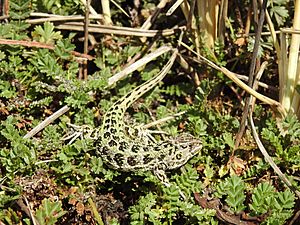Magellan's tree iguana facts for kids
Quick facts for kids Magellan's tree iguana |
|
|---|---|
 |
|
| Conservation status | |
| Scientific classification | |
| Genus: |
Liolaemus
|
| Species: |
magellanicus
|
Liolaemus magellanicus, also known as Magellan's tree iguana, is a special type of lizard. It belongs to the Iguanidae family. This lizard is famous for living further south than any other lizard in the world! Imagine a lizard living in some of the coldest places on Earth.
Contents
Where It Lives: Distribution and Habitat
This amazing lizard makes its home in a region called Patagonia. You can find it in both Chile and Argentina. It also lives on a large island called Isla Grande de Tierra del Fuego.
These areas are known for their cold weather. The Magellan's tree iguana lives in places with strong winds and low temperatures. It often lives among rocks or in grassy areas. This helps it find shelter from the harsh environment.
What It Looks Like: Appearance
The Magellan's tree iguana is a medium-sized lizard. It has a strong body and a tail that is usually longer than its body. Its skin can be many different colors. You might see shades of brown, gray, or even green. Some lizards have cool patterns like spots or stripes. These colors help it blend in with its rocky or grassy home. This is called camouflage.
What It Eats: Diet
Like many lizards, the Magellan's tree iguana is an omnivore. This means it eats both plants and animals. Its diet mostly includes small insects. It might munch on beetles, ants, or spiders. It also eats parts of plants, such as leaves or flowers. Finding food in its cold habitat can be a challenge. So, it has to be good at hunting and foraging.
How It Lives: Behavior
Magellan's tree iguanas are mostly active during the day. They love to bask in the sun. This helps them warm up their bodies. Lizards are cold-blooded animals. This means their body temperature changes with their surroundings. So, sunlight is very important for them to stay warm.
When it gets too cold, they hide. They might go under rocks or into small burrows. This helps them stay safe from predators. It also protects them from the extreme cold. They are very good at climbing. This helps them move around their rocky homes.
Life Cycle and Reproduction
The Magellan's tree iguana reproduces by laying eggs. Female lizards lay their eggs in a safe spot. This is usually in the ground or under rocks. The eggs are kept warm by the sun. After a while, tiny baby lizards hatch from the eggs.
These young lizards are very small. They look like mini versions of their parents. They have to learn to find food and stay safe very quickly. The life cycle of these lizards is adapted to the cold climate. They need to grow and reproduce during the warmer months.
Conservation Status
The Magellan's tree iguana is currently listed as "Least Concern" by the International Union for Conservation of Nature (IUCN). This means that its population is stable. It is not considered to be in danger of disappearing. However, it is always important to protect their natural habitat. This helps ensure they can continue to thrive in the wild.
See also
 In Spanish: Lagartija magallánica para niños
In Spanish: Lagartija magallánica para niños


